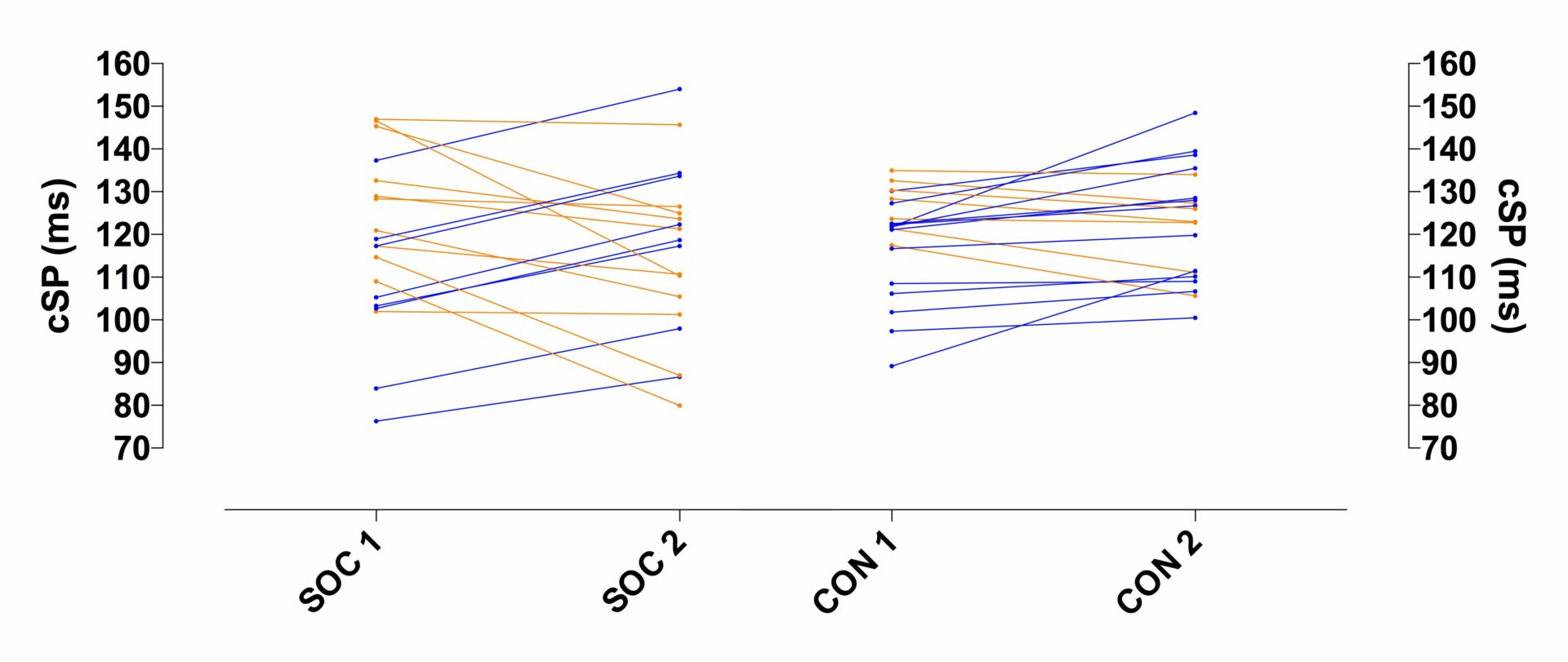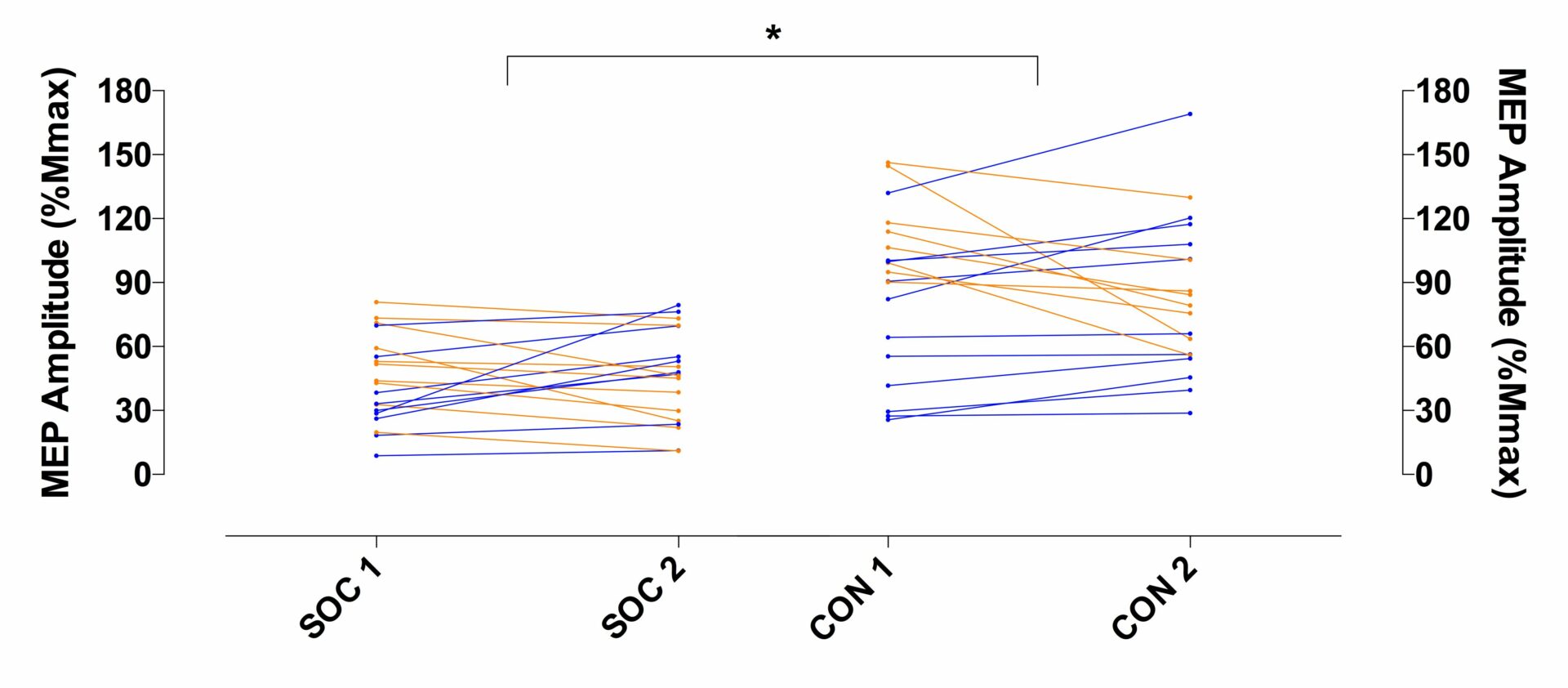Introduction: Concussive and subconcussive head impacts in soccer can negatively affect player availability. Assessment of concussive and subconcussive impacts in field settings is limited to indirect methods such as balance as a proxy for motor control, or subjective methods involving cognitive function. Changes to corticospinal excitability and corticomotor inhibition in relation to subconcussive/concussive impacts can be measured using transcranial magnetic stimulation (TMS) (Di Virgilio et al, 2016; 2019; Ntikas et al, 2021). This study will inform practitioners and researchers regarding the reliability of TMS to monitor concussion and subconcussion when assessing soccer players.
Methods: Nineteen soccer players (14 Males, 5 Females, Age = 22 ± 3 years, body mass = 72.9 ± 8.3 kg, height = 175.4 ± 10.2 cm) and twenty healthy active controls (16 Males, 4 Females, Age = 24.3 ± 4 years, body mass = 76.4 ± 13.6 kg, Height = 174.9 ± 9.8 cm) completed two identical experimental sessions spaced 7-14 days apart, where their corticospinal excitability and corticomotor inhibition were assessed. Surface electromyography (EMG) electrodes were affixed to the rectus femoris of the dominant leg. Participants performed three 5 second knee extension maximum isometric voluntary contractions (MVC) at a 60° joint angle, with a 60 second rest period between contractions. A single pulse transcranial magnetic stimulation was delivered over the primary motor cortex (M1) during each MVC to measure corticomotor inhibition, which was quantified as the EMG silent period from TMS stimulus artefact to resumption of normal EMG activity. To assess corticospinal excitability, participants performed a 20% MVC contraction, while 20 single pulse stimulations were delivered over M1. Corticomotor excitation was measured as the average of the motor evoked potentials’ peak-to-peak amplitudes and expressed relative to the maximal excitability of the muscle (Mmax). Reliability of these measures within population and inter-rater (n = 2) was measured using a two-way random model of intraclass correlation coefficient, and coefficient of variation. Group differences were assessed using a 2-way ANOVA.
Results: Good inter-day reliability was evident for corticomotor inhibition in soccer players (ICC = 0.61) and controls (ICC = 0.70) and corticospinal excitability in soccer players (ICC = 0.59) and controls (ICC = 0.70). Corticomotor inhibition also showed excellent inter-rater reliability (ICC = 0.87). Corticomotor inhibition showed lower coefficient of variation than excitability in soccer players (Inhibition=15.2%; Excitability=41.6%) and in controls (inhibition = 9.7%; Excitability = 39.5%). No group differences between soccer players and healthy active individuals were found on the corticomotor inhibition value (p > 0.05), but levels of corticospinal excitability were significantly lower in soccer players (45.1±20.8 vs 85.4±6.2%Mmax, p < 0.001).
Discussion: We show that corticomotor inhibition and corticospinal excitability are stable and maintain good degrees of reliability when assessed over different days and between investigators in soccer players, despite their routine exposure to head impacts. However, based on intra-group reliability and group differences of the levels of excitability, we conclude that corticomotor inhibition is best suited for the evaluation of outcomes and monitoring of recovery following head impacts in contact sport.
Biomedical Basis of Elite Performance 2022 (University of Nottingham, UK) (2022) Proc Physiol Soc 49, PC48
Poster Communications: TMS-Derived Corticomotor Inhibition is Reliable to Evaluate Brain Health in Soccer Players
Thomas Di Virgilio1, ragul selvamoorthy1, Angus Hunter1,2, Magdalena Ietswaart3
1 Sport and Exercise Sciences, University of Stirling, UK 2 Musculoskeletal Physiology Research Group, Sport, Health and Performance Enhancement Research Centre, School of Science and Technology, Nottingham Trent University 3 University of Stirling
View other abstracts by:
Where applicable, experiments conform with Society ethical requirements.


